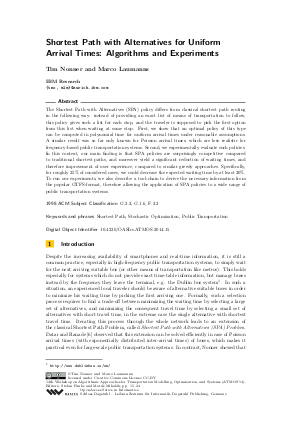Shortest Path with Alternatives for Uniform Arrival Times: Algorithms and Experiments
Authors Tim Nonner, Marco Laumanns
-
Part of:
Volume:
14th Workshop on Algorithmic Approaches for Transportation Modelling, Optimization, and Systems (ATMOS 2014)
Part of: Series: Open Access Series in Informatics (OASIcs)
Part of: Conference: Symposium on Algorithmic Approaches for Transportation Modelling, Optimization, and Systems (ATMOS) - License:
 Creative Commons Attribution 3.0 Unported license
Creative Commons Attribution 3.0 Unported license
- Publication Date: 2014-09-19
File

PDF
OASIcs.ATMOS.2014.15.pdf
- Filesize: 0.53 MB
- 10 pages
Document Identifiers
Subject Classification
Keywords
- Shortest Path
- Stochastic Optimization
- Public Transportation
Metrics
- Access Statistics
-
Total Accesses (updated on a weekly basis)
0PDF Downloads0Metadata Views
Abstract
The Shortest Path with Alternatives (SPA) policy differs from classical shortest path routing in the following way: instead of providing an exact list of means of transportation to follow, this policy gives such a list for each stop, and the traveler is supposed to pick the first option from this list when waiting at some stop. First, we show that an optimal policy of this type can be computed in polynomial time for uniform arrival times under reasonable assumptions. A similar result was so far only known for Poisson arrival times, which are less realistic for frequency-based public transportation systems. Second, we experimentally evaluate such policies. In this context, our main finding is that SPA policies are surprisingly competitive compared to traditional shortest paths, and moreover yield a significant reduction of waiting times, and therefore improvement of user experience, compared to similar greedy approaches. Specifically, for roughly 25% of considered cases, we could decrease the expected waiting time by at least 20%. To run our experiments, we also describe a tool-chain to derive the necessary information from the popular GTFS-format, therefore allowing the application of SPA policies to a wide range of public transportation systems.
Cite As Get BibTex
Tim Nonner and Marco Laumanns. Shortest Path with Alternatives for Uniform Arrival Times: Algorithms and Experiments. In 14th Workshop on Algorithmic Approaches for Transportation Modelling, Optimization, and Systems. Open Access Series in Informatics (OASIcs), Volume 42, pp. 15-24, Schloss Dagstuhl – Leibniz-Zentrum für Informatik (2014)
https://doi.org/10.4230/OASIcs.ATMOS.2014.15
BibTex
@InProceedings{nonner_et_al:OASIcs.ATMOS.2014.15,
author = {Nonner, Tim and Laumanns, Marco},
title = {{Shortest Path with Alternatives for Uniform Arrival Times: Algorithms and Experiments}},
booktitle = {14th Workshop on Algorithmic Approaches for Transportation Modelling, Optimization, and Systems},
pages = {15--24},
series = {Open Access Series in Informatics (OASIcs)},
ISBN = {978-3-939897-75-0},
ISSN = {2190-6807},
year = {2014},
volume = {42},
editor = {Funke, Stefan and Mihal\'{a}k, Mat\'{u}s},
publisher = {Schloss Dagstuhl -- Leibniz-Zentrum f{\"u}r Informatik},
address = {Dagstuhl, Germany},
URL = {https://drops.dagstuhl.de/entities/document/10.4230/OASIcs.ATMOS.2014.15},
URN = {urn:nbn:de:0030-drops-47494},
doi = {10.4230/OASIcs.ATMOS.2014.15},
annote = {Keywords: Shortest Path, Stochastic Optimization, Public Transportation}
}
Author Details
References
-
Utku Günay Acer, Paolo Giaccone, David Hay, Giovanni Neglia, and Saed Tarapiah. Timely data delivery in a realistic bus network. IEEE Transactions on Vehicular Technology, 61(3):1251-1265, 2012.

-
Hannah Bast, Daniel Delling, Andrew Goldberg, Matthias Müller-Hannemann, Thomas Pajor, Peter Sanders, Dorothea Wagner, and Renato Werneck. Route planning in transportation networks. Technical Report MSR-TR-2014-4, Microsoft Research, January 2014.

-
Hannah Bast and Sabine Storandt. Flow-based guidebook routing. In Proceedings of the 16th Workshop on Algorithm Engineering and Experiments (ALENEX'14), pages 155-165, 2014.

-
Dimitri P. Bertsekas and John N. Tsitsiklis. An analysis of stochastic shortest path problems. Math. Oper. Res., 16:580-595, August 1991.

-
Justin Boyan and Michael Mitzenmacher. Improved results for route planning in stochastic transportation. In Proceedings of the 12th annual ACM-SIAM Symposium on Discrete Algorithms (SODA'01), pages 895-902, 2001.

-
Mayur Datar and Abhiram G. Ranade. Commuting with delay prone buses. In Proceedings of the 11th Annual ACM-SIAM Symposium on Discrete Algorithms (SODA'00), pages 22-29, 2000.

-
Julian Dibbelt, Thomas Pajor, Ben Strasser, and Dorothea Wagner. Intriguingly simple and fast transit routing. In Proceedings of the 12th International Symposium on Experimental Algorithms (SEA'13), pages 43-54, 2013.

-
Evdokia Nikolova, Jonathan A Kelner, Matthew Brand, and Michael Mitzenmacher. Stochastic shortest paths via quasi-convex maximization. In Proceedings of the 14th Annual European Symposium on Algorithms (ESA'06), pages 552-563. Springer, 2006.

-
Tim Nonner. Polynomial-time approximation schemes for shortest path with alternatives. In Proceedings of the 20th Annual European Symposium on Algorithms (ESA'12), pages 755-765, 2012.

